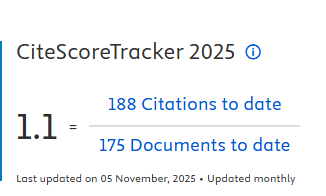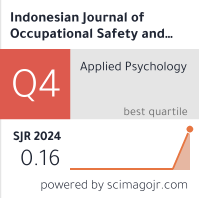Work Fatigue among Women Fish Processors on the South Coast of Jember District, Indonesia

Introduction: Occupational Health and Safety (OHS) problems need to be addressed because the cause of the high number of work accidents is work fatigue. One of the factors that causes work fatigue is workload. Coastal women, who are identified as a marginal group with a low level of education, have a large role in fishing households and have a high workload. This research aims to analyze work fatigue based on workload. Methods: This research is an analytical observational study with a cross-sectional design. The respondents involved were fishermen's wives who lived in the research locus (Puger District). The number of respondents in this study was 75 people using proportional stratified random sampling techniques. The quantitative data collected include sociodemographic factors, namely demographic factors (age and body mass index) and work factors (work period, workload, and work climate), as well as work fatigue factors. Data collection was carried out using questionnaires and measurements. The data in this study were analyzed univariately and bivariately using the Spearman rank correlation coefficient test which was presented in table form accompanied by narrative. Results: The results show that 44.0% have a level of heavy work fatigue. The risk factors of age, working time, and workload have a significant relationship with work fatigue at work. Body mass index (BMI) and work climate were not significantly related to work fatigue. Conclusion: The high workload of women fish processors causes a lot of work fatigue, so it requires attention from industry owners to manage working time.
Ameyaw, A. B., et al. (2020). From Fish to Cash: Analyzing the Role of Women in Fisheries in the Western Region of Ghana. Marine Policy, 113, 103790.
Bláfoss, R.. et al. (2019) ‘Physical Workload and Bodily Fatigue after Work: Cross-Sectional Study among 5000 Workers’, European Journal of Public Health, 29(5), pp. 837–842.
Bonini‐Rocha, A., et al. (2021) ‘Prevalence of Musculoskeletal Disorders and Risk Factors in Recyclable Material Waste Pickers From the Dump of the Structural City in Brasília, Brazil’, Waste Management, 125, pp. 98–102.
Brooks, G. A., et al. (2022) Lactate in Contemporary Biology: A Phoenix Risen. The Journal of Physiology, 600(5), 1229–1251.
Bureau of Labor Statistic (2022) Employee Tenure in 2022, U.S Department of Labor.
Cahyani, M.T. and Pramana, A.N. (2022) ‘Pengaruh Paparan Karbon Monoksida dan Karakteristik Individu Terhadap Kelelahan Kerja pada Pekerja Pengasapan Ikan di Kampung Ikan Asap Penatarsewu Kabupaten Sidoarjo’, Indonesian Journal of Health Community, 3(1), p. 20.
Couto, M.C.B.M., et al. (2019) ‘Prevalence and Work-Related Factors Associated with Lower Back Musculoskeletal Disorders in Female Shellfish Gatherers in Saubara, Bahia-Brazil’, International Journal of Environmental Research and Public Health, 16(5), pp. 1–15.
Deyulmar, B.A., Suroto and Wahyuni, I. (2018) ‘Analisis Faktor-Faktor yang Berhubungan dengan Kelelahan Kerja pada Pekerja Pembuat Kerupuk Opak di Desa Ngadikerso, Kabupaten Semarang’, Jurnal Kesehatan Masyarakat, 6(4), pp. 278–285.
Dwiyanti, E., and Mustofani (2019) ‘Relationship between Work Climate and Physical Workload with Work-Related Fatigue’, The Indonesian Journal of Occupational Safety and Health, 8(2), pp. 150–157.
Erliana, C.I., Syarifuddin, S. and Trisyiam, Y. (2023) ‘Analisis Pengukuran Beban Kerja Fisik dan Mental Karyawan Menggunakan Metode Cardiovascular Load dan Nasa Task Load Index di PT. Charoen Pokphan Cabang Gebang’, Industrial Engineering Journal, 12(1), pp. 39–48.
Evoy, R. and Case, S. (2022) ‘Prevalence of Adverse Health Behaviors and Conditions among Maritime Workers’, Journal of Occupational and Environmental Medicine, 64(4), pp. 350–355.
Gao, C., et al.(2018) ‘Occupational Heat Stress Assessment and Protective Strategies in The Context of Climate Change’, International Journal of Biometeorology, 62(3), pp. 359–371.
Gawe, P., Ruliati, L.P. and Tira, D.S.(2022) ‘Relationship between Ergonomic Factors and Lower Back Pain on Dry Fish Processing Workers’, Journal of Community Health, 4(1), pp. 21–33.
Gundmi, R.N.V., et al. (2021) ‘Characteristics of Musculoskeletal Pain among Employees of Fish Processing Factory in Udupi, Karnataka’, Indian Journal of Public Health, 65(2), pp. 194–197.
Gutierrez, I.A., et al.(2019) ‘Transitions between Informal and Formal Employment: Results From a Worker Survey in Bangladesh’, IZA Journal of Development and Migration, 9(1).
Hasibuan, C.F., Munte, S. and Lubis, S.B. (2021) ‘Analisis Pengukuran Beban Kerja dengan Menggunakan Cardiovascular Load (CVL) pada PT. XYZ’, Journal of Industrial and Manufacture Engineering, pp. 65–71.
Indrayani, R.I., et al. (2023) ‘Aspects of Personal Safety while Sailing for Fishermen in Jember Regency’, Medical Technology and Public Health Journal, 7(1). https://doi.org/10.33086/mtphj.v7i1.3629
ILO (2016) Workplace Stress: a collective challenge, Workplace Stress: A collective challenge.
International Labour Organization (2019) Time to Act for SDG 8.
Jacklitsch, B., et al. (2016) ‘NIOSH Criteria for a Recommended Standard: Occupational Exposure to Heat and Hot Environments’, Cincinnati, OH: U.S. Department of Health and Human Services, Centers for Disease Control and Prevention, National Institute for Occupational Safety and Health, DHHS (NIOSH)
Jeebhay, M.F., Robins, T.G. and Lopata, A.L. (2023) ‘World at work: Fish Processing Workers’, Occupational and Environmental Medicine, 61(5), pp. 471–474.
Juliana, M., Camelia, A. and Rahmiwati, A. (2018) ‘Analisis Faktor Risiko Kelelahan Kerja pada Karyawan Bagian Produksi di PT. Arwana Anugerah Keramik’, Jurnal Ilmu Kesehatan Masyarakat, 9(1), pp. 53–63.
Karliman, L.L. and Sarvia, E. (2019) ‘Perancangan Alat Material Handling untuk Mereduksi Tingkat Risiko Cedera Tulang Belakang Operator pada Aktivitas Pemindahan Semen di Toko Bangunan’, Journal of Integrated System, 2(2), pp. 170–191.
Karmila, R.P., Setyaningsih, Y., and Nurjazuli. (2020) ‘The Influence of Total Suspended Particulate Carboksihemoglobinand Individual Characteristics of Vital Capacity of Lung Fish Craffickers in Fishing Center’, International Journal of Health, Education and Social,3(1), pp. 24–35.
Khan, I.N. and Machhindranath, S.P. (2022) ‘Socioeconomic Status and Occupational Health of Domestic Workers in Karad’, International Journal of All Research Education & Scientific Methods, 18(4), pp. 5–10.
Kurgiyanto, W., Suroto and Ekawati. (2017) ‘Analisis Hubungan Beban Kerja Fisik, Masa Kerja, Usia, dan Jenis Kelamin terhadap Tingkat Kelelahan Kerja pada Pekerja Bagian Pembuatan Kulit Lumpia’, Jurnal Kesehatan Masyarakat, 5(5), pp. 413–423.
Lincoln, J.M., et al. (2021) ‘Occupational Health Research in the Commercial Fishing Industry’, Journal of Agromedicine, 26(1), pp. 28–30.
Malik, I., Hardi, I. and Abbas, H.H. (2021) ‘Faktor yang Berhubungan dengan Kelelahan Kerja di PT. Industri Kapal Indonesia (Persero) Makassar’, Window of Public Health Journal, pp. 580–589.
Márquez Gómez, M. (2020) ‘Prediction of Work-Related Musculoskeletal Discomfort in The Meat Processing Industry Using Statistical Models’, International Journal of Industrial Ergonomics, 75.
Mekonnen, T.H., Yenealem, D.G. and Geberu, D.M. (2020) ‘Physical Environmental and Occupational Factors Inducing Work-Related Neck and Shoulder Pains among Self-Employed Tailors of Informal Sectors in Ethiopia, 2019 : Results From A Community-Based Cross-Sectional Study’, BMC Public Health, 20:1265 pp. 1–10.
Mekonnen, T.H., Yenealem, D.G., and Geberu, D.M. (2020). Physical Environmental and Occupational Factors Inducing Work-Related Neck and Shoulder Pains among Self-Employed Tailors of Informal Sectors in Ethiopia, BMC Public Health, 20.
Ministry of Manpower and Transmigration (2011) PER.13/MEN/X/2011 Tentang Nilai Ambang Batas Faktor Fisika dan Kimia di Tempat Kerja. Jakarta: Ministry of Manpower and Transmigration.
Ministry of Manpower and Transmigration (2018) PER.05/MEN/2018 Tentang Keselamatan dan Kesehatan Kerja Lingkungan Kerja. Jakarta: Ministry of Manpower and Transmigration.
Navya, V., Sumit, K. and Tiwari, R.R. (2023) ‘Occupational Injuries among Female Seafood Processing Workers in Prakasam, Andhra Pradesh, India’, Women and Health, 63(1), pp. 44–50.
Neranjala, T.P.U., Eranga, W.G.D. and Dissanayake, D.C.T. (2022) ‘Dried Fish Production and Trade in Negombo, Sri Lanka’, Sri Lanka Journal of Aquatic Sciences, 27(1), p. 31.
Nordander, C., et al. (2009) ‘Risk of Musculoskeletal Disorders among Females and Males in Repetitive/ Constrained Work’, Ergonomics, 52(10), pp. 1226–1239.
Rini, W. N. E. and Lanita, U. (2023) 'Analysis of the Risk Factors of Work Fatigue in Formal and Informal Workers', Jambi Medical Journal: Jurnal Kedokteran dan Kesehatan, 11(3), pp. 257-266.
Nuraini, N., Winarko and Warno, S.B.E. (2022) ‘Faktor yang Berpengaruh terhadap Kelelahan (Studi pada Pekerja Proyek Kapal Perang di PT. X Tahun 2018)’, Gema Lingkungan Kesehatan, 20(1), pp. 1–8.
Oktaviara, S. (2021) Analisis Tingkat Kelelahan dan Beban Kerja Mental Operator Chane Menggunakan Metode Sofi dan Nasa-TLX.Undergraduate Thesis. Surakarta: Universitas Muhammadiyah Surakarta.
Pal, A., De, S., et al, P.C.(2019) ‘Relationship between Body Mass Index and Musculoskeletal Disorders among Women Cultivators’, Health and Population: Perspectives and Issues, 42(3&4), pp. 90–99.
Purbasari, A. and Purnomo, A.J. (2019) ‘Penilaian Beban Fisik pada Proses Assembly Manual Menggunakan Metode Fisiologis’, Sigma Teknika, 2(1), p. 123.
Rahmawati, F. and Karmeli, E. (2022) ‘Peranan Perempuan Pesisir dalam Meningkatkan Ekonomi Rumah Tangga’, Samalewa: Jurnal Riset & Kajian, pp. 90–99.
Rashid, M.U. et al. (2023) ‘Women in Dry Fish Processing Activities: an In-Depth Study of a Selected Coastal Region of Bangladesh’, Development in Practice, 33(8),pp. 910-925
Safira, E.D., Pulungan, R.M. and Arbitera, C. (2020) ‘Kelelahan Kerja pada Pekerja di PT. Indonesia Power Unit Pembangkitan dan Jasa Pembangkitan (UPJP) Priok’, Jurnal Kesehatan, 11(2), p. 265.
Sari, F.P., Ramadani, M. and Fahriati, A.R. (2022) ‘Analisis Beban Kerja Metode Cardiovascular Load dengan Kelelahan Kerja’, Journal of Midwifery Care, 2(2), p. 129.
Sartono, Martaferry and Winaresmi (2016) ‘Hubungan Faktor Internal dan Faktor Eksternal Karyawan Dengan Kelelahan Kerja di Bagian Produksi CV. Sinergie Laundry Jakarta Barat’, Artikel Kesehatan Masyarakat, 1(1), pp. 64–72.
Setyaningsih, Y. and Wahyuni, I. (2020) ‘Identification of Musculoskeletal Disorder Complaint, Dermatitis Incident and Respiratory Disorder in Smoked Fish Worker’, E3S Web of Conferences 202(4),12003.
Silitonga, S.F.,et al. (2022) ‘The Relationship of Energy and Macro Nutrient Intake on Fatigue Levels of Female Workers at the Bandarharjo Fish Smoking Center, Semarang City’, Journal of Public Health for Tropical and Coastal Region, 5(3), pp. 155–164.
Sm, E.K., Junus, S. and Hasanuddin, H. (2021) ‘Hubungan Antara Kelelahan dan Keluhan Fisik Berdasarkan Jenis Kelamin pada Pekerja Pengalengan Ikan’, Jambura Industrial Review (JIREV), 1(1), pp. 7–14.
Suma’mur (2013) Corporate Hygiene And Occupational Health (Hiperkes). 2nd ed. Jakarta: Sagung Seto.
Sumardiyono, Rochmah, S.C. and Rinawati, S. (2023) ‘Faktor-Faktor yang Berhubungan dengan Kelelahan Kerja pada Pekerja Penyapu Jalan di Kota Surakarta’, Journal of Applied Agriculture, Health, and Technology, 1(2), pp. 34–42.
Suntari, W.A., Suroto, S. and Ekawati, E. (2023) ‘Factors Relating to Productivity of Fish Unloading Workers’, The Indonesian Journal of Occupational Safety and Health, 12(1), pp. 115–123.
Sutarto, T.O., Soemarko, D.S. and Ichsan, S. (2022) ‘The Association of Heat Exposure and Hydration Status among Production Workers in Fish Processing Company Abstrak’, The Indonesian Journal of Community and Occupational Medicine (IJCOM), 1(3), pp. 146–153.
Syron, L.N., et al. (2019) ‘Safety and Health Programs in Alaska’s Seafood Processing Industry: Interviews with Safety and Health Managers’, Journal of Agromedicine, 24(4), pp. 449–461. A
Thamrin, Y., et al. (2019) ‘Determinants of Occupational Health and Safety Problems among Seaweed Workers in Takalar Regency’, Indian Journal of Public Health Research and Development, 10(1), pp. 1214–1219.
Thorvaldsen, T., et al. (2020) ‘Occupational Health, Safety, and Work Environments in Norwegian Fish Farming-Employee Perspective’, Aquaculture, 524,
Wulandari, N., Indrianti, D.T. and Hilmi, M.I. (2022) ‘Analisis Gender Peran Perempuan Pesisir pada Ketahanan Keluarga di Desa Puger Kulon Kabupaten Jember’, Jurnal Cendekiawan Ilmiah PLS, 7(1), pp. 52–60.
Yamaula, S.M., Suwondo, A. and Widjasena, B. (2021) ‘Hubungan Antara Beban Kerja Fisik dengan Kelelahan Kerja pada Industri Pengolahan Ikan Asin di UD. X’, Jurnal Kesehatan Masyarakat, 9, pp. 112–118.
Yudha, A.D. and Fitriani, F. (2022) ‘Relationship of Nutritional Status, Nutritional Intake and History of Disease With Work Fatigue in Informal Sector Rice Farmers in Teupin Panah Village’, Morfai Journal, 2(2), pp. 445–450.

This work is licensed under a Creative Commons Attribution-NonCommercial-ShareAlike 4.0 International License.

In order to be accepted and published by The Indonesian Journal of Occupational Safety and Health, Author(s) who submit an article should complete all the review process. The copyright of received articles assigned to the The Indonesian Journal of Occupational Safety and Health and Department of Safety and Health, Universitas Airlangga as publishers of the journal. The intended copyright includes the rights to publish articles in various forms (including reprints).
The Editorial Team of The Indonesian Journal Of Occupational Safety and Health and Department of Safety and Health strive to ensure that no errors occur in the articles that have been published, both data errors and statements in the article.
Users of this website will be licensed to use materials from this website following the Creative Commons Attribution-NonCommercial-ShareAlike 4.0 International License. No fees charged. Please use the materials accordingly.
------------------------------------------------------------------------------------------------------------------------------------------------------------------------------------------
Attribution ” You must give appropriate credit, provide a link to the license, and indicate if changes were made. You may do so in any reasonable manner, but not in any way that suggests the licensor endorses you or your use.
NonCommercial ” You may not use the material for commercial purposes.
ShareAlike ” If you remix, transform, or build upon the material, you must distribute your contributions under the same license as the original.







 How to Submit Articles in OJS
How to Submit Articles in OJS

























